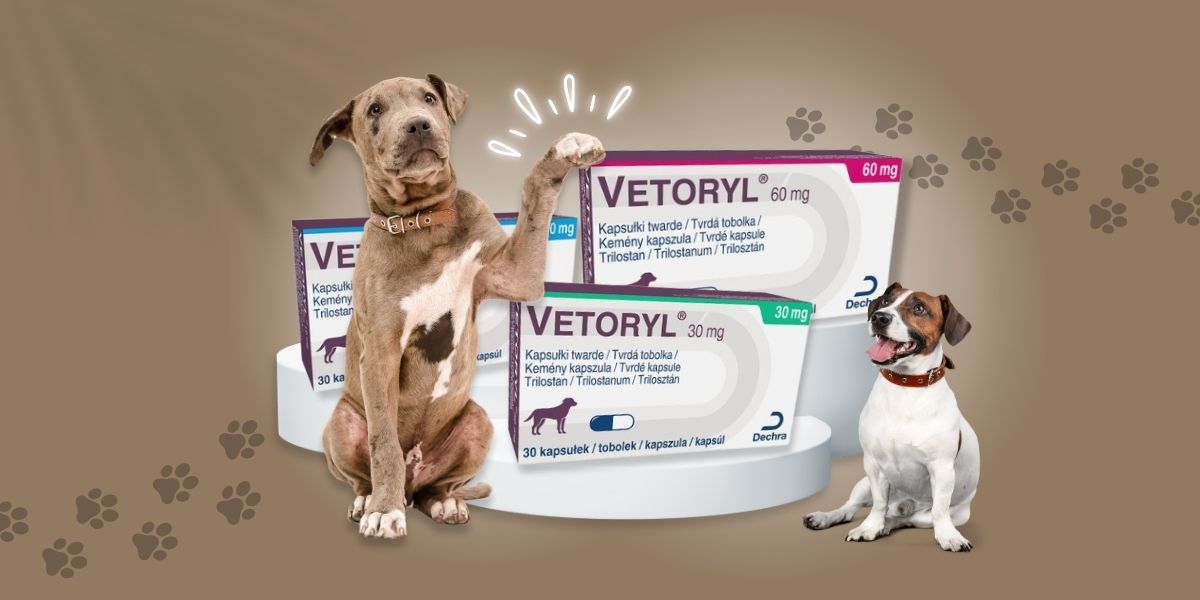Vetoryl: Leading Treatment for Cushing’s Syndrome in Dogs
Cushing’s syndrome, also known as hyperadrenocorticism, is a complex endocrine disorder that affects dogs. It occurs when the body produces excessive cortisol, a hormone crucial for regulating various bodily functions, such as metabolism, blood sugar levels, and inflammation response.
Understanding Cortisol and Its Role in Dogs
Cortisol is vital in maintaining homeostasis, the body’s internal balance, and is often called the “stress hormone.” It helps dogs adapt to stressful situations, regulate blood sugar levels, and maintain healthy blood pressure.
The Overproduction of Cortisol: A Threat to Dogs’ Well-being
When the body produces too much cortisol, it can lead to a cascade of health problems. This excess cortisol can cause a range of symptoms, including:
- Increased thirst and urination: The body tries to expel the excess cortisol through urination, leading to frequent trips to the water bowl and more accidents indoors.
- Increased appetite and reduced activity: Despite eating more, dogs with Cushing’s may experience weight loss due to the body’s increased metabolism. They may also seem less energetic and exhibit a reduced interest in activities they once enjoyed.
- Thinning skin and hair loss: Cortisol can weaken the skin’s elasticity, making it more prone to tears and infections. Hair follicles may also be affected, leading to thinning fur and patchy hair loss.
- Potbelly: Excess cortisol can accumulate fat around the abdomen, giving the dog a pot-bellied appearance.
- Excessive panting: The increased metabolism caused by cortisol can lead to panting, even at rest.
Diagnosing Cushing’s Syndrome: A Multifaceted Approach
Due to the varied symptoms of Cushing’s syndrome, it can be challenging to diagnose. Your veterinarian will conduct a thorough physical examination, reviewing your dog’s medical history and any recent changes in behaviour or appearance. They may also recommend a series of diagnostic tests, including:
- Urinalysis and blood tests: These tests assess kidney function, electrolyte levels, and elevated cortisol levels.
- Imaging studies: X-rays or ultrasounds can help visualize the adrenal glands, the primary source of cortisol production.
- Additional tests: In some cases, more specialized tests, such as an ACTH stimulation test or an adrenal gland biopsy, may be required for a definitive diagnosis.
Treatment Options: Managing Cushing’s Syndrome Effectively
The specific treatment for Cushing’s syndrome will depend on the type of Cushing’s syndrome your dog has and the severity of their symptoms.
Pituitary-dependent Cushing’s Syndrome
This is the most common type, affecting about 85-90% of Cushing’s syndrome cases in dogs. Treatment involves surgery to remove the pituitary gland tumour.
Adrenal-dependent Cushing’s Syndrome
This type is less common, affecting about 10-15% of cases. Treatment options include:
- Adrenalectomy: Surgical removal of one of the adrenal glands is an effective treatment option for adrenal-dependent Cushing’s syndrome.
- Medical management: If surgery is not an option, medications can be used to block cortisol production or regulate the body’s cortisol levels.
Vetoryl: A Medical Breakthrough for Cushing’s Syndrome
Vetoryl (trilostane) is a prescription medication that is the only FDA-approved treatment for both pituitary-dependent and adrenal-dependent Cushing’s syndrome in dogs. It works by blocking the production of cortisol, effectively managing the symptoms of Cushing’s syndrome and improving dogs’ quality of life.
How Vetoryl Works
Vetoryl works by inhibiting the enzyme 11β-hydroxylase, which converts cholesterol into cortisol. By blocking this enzyme, Vetoryl prevents the excessive production of cortisol, alleviating Cushing’s syndrome symptoms.
Benefits of Vetoryl
Vetoryl offers several benefits for dogs with Cushing’s syndrome:
- Effectively manages Cushing’s symptoms: Vetoryl has been shown to significantly reduce the signs of Cushing’s syndrome, including increased thirst and urination, decreased appetite, thinning skin, and hair loss.
- Improves dogs’ quality of life: By effectively managing Cushing’s symptoms, Vetoryl can significantly improve dogs’ quality of life, allowing them to feel more comfortable and enjoy their lives again.
- Easy to administer: Vetoryl is administered orally once daily.
If you need treatment for your furry pet, check our partner vet clinics, which diagnose the Cushing Syndrome in dogs and administer Vetoryl as an effective treatment.



